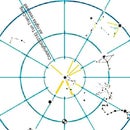Introduction: Caution in Finding North by Bi-sector Line
by tonytran2015 (Melbourne, Australia).
There is currently wide advocating for the application of the method of finding North direction by “the bisector line of a horizontal watch”. There have even been proposals to use the method on the new and full Moon as the position of the Sun can be determined from the position of new or full Moon [1], [2]. However people should remember the basic limitations of the method and if they exceed its hard limitation perilous and catastrophic consequences (such as direction errors of 90 degrees or even direction reversal sending people astray) may result.
Step 1: Possible Perilous Situations.
The picture in the title page shows the two applications to Southern (red direction line) and Northern (green direction line) hemispheres of the method of "bisector line of a horizontal watch”. The limitations for each case are clearly displayed in yellow.
Here are the few possible perilous situations:
a/- On any summer solstice day, at latitude +23.5 degrees, the Sun rises in ENE, travels to a point in the East direction, to the zenith, to a point in West direction, then sets in WNW.
b/- On any summer solstice day, at latitude +20 degrees, the Sun rises in ENE, travels to a point in North direction, then sets in WNW.
If the method of “bisector line of a horizontal watch” is used for case a, the error will be a flipping +/- 90 degrees near to noon while if it is used for case b, the error will be a devastating 180 degrees around noon time.
With such situations in mind, people using the method of “bisector line of a horizontal watch” should heed the warning to preserve its accuracy and NOT to use it in zones near to the equator, with less than 30 degrees latitude (low temperate and tropical zones).
Users of “bisector line of a horizontal watch” should be even more cautious when they guess the position of the Sun in the sky from the position of the Moon and then apply the method. A perilous situation may arise as illustrated in the following:
c/- On a summer solstice day, at latitude +26 degrees, the Sun rises in ENE, travels to a point in South direction at mid-day then sets in WNW. However at night the Moon rises in ENE, may travel to a point in North direction at mid-night then sets in WNW. Note here that the Moon may go to the North while the Sun goes to the South at their highest altitudes and the Moon does not necessarily retrace the path of the Sun 12 hour later, as the proponents of the extension had wished.
So users should be even more cautious when guessing the position of the Sun in the sky from the position of the Moon. They should heed the warning to preserve its accuracy and NOT guess the position of the Sun from the Moon to use the method in zones near to the equator, with less than 40 degrees latitude (temperate and tropical zones).
Step 2: Updating to a Safer Method.
Figures 1,2 (with copyrights) from references [3], [4] showing safer methods to find North direction and time for Northern and Southern hemispheres.
For accuracy and safety, it is worthy for them to switch to my new method of “inclined bisector line of a tilted vertical watch” [3,4]. It has no latitude limitation and requires only the declination of the Sun and the simple knowledge that the Sun is rising or falling.
References
[1]. Unknown Author. Use the moon and a watch to find north, Boy’s Life magazine ,http://boyslife.org/video-audio/134162/use-the-moon-and-a-watch-to-find-North, 2011 Mar.
[2]. Frank Williams, Finding North By The Moon In The Southern Hemisphere, BushcraftNZ, http://bushcraft.org.nz/m/blogpost?id=5745113%3AB... 2011 Jul 24.
[3]. tonytran2015, Finding North with a watch more accurately, ,Instructables,
https://www.instructables.com/id/Finding-North-more...
uploaded 2015 May 24.
[4]. tonytran2015, Finding North with a watch more accurately p2, Instructables,
https://www.instructables.com/id/Finding-North-with... , uploaded 2015 May 25.











